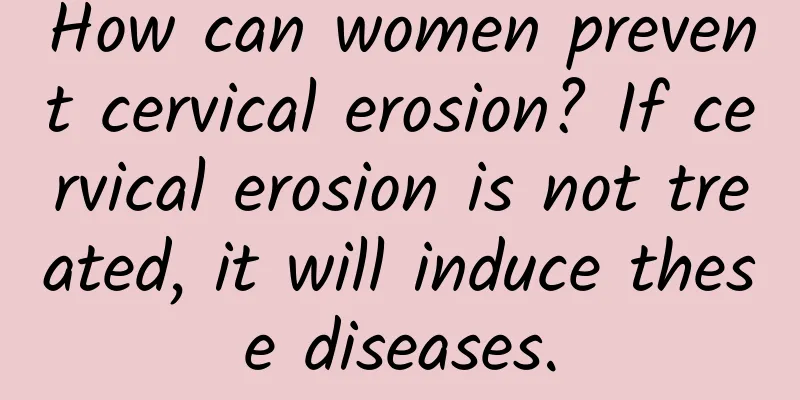Will women with cervical erosion bleed during pregnancy? Some suggestions for women with cervical erosion

|
There are many mucous membranes on the surface of a woman's uterus, and these mucous membranes are prone to inflammation when stimulated. When these inflammations are more serious, cervical erosion will occur. Cervical erosion, a gynecological disease, is very common in women. Especially for married women, they are more likely to have cervical erosion. So will a woman bleed when she has cervical erosion during pregnancy? Most women will have varying degrees of cervical erosion after marriage. After pregnancy, as the pregnancy progresses, the levels of estrogen and progesterone in the pregnant woman's body continue to increase, causing the columnar epithelium of the cervix to migrate outward, tissue proliferation, and cervical erosion symptoms to become significantly aggravated, and vaginal bleeding is likely to occur at this time. Excessive sexual activity, overeating hot and irritating foods such as chocolate, peppers, longans, or hot pot can also aggravate bleeding symptoms. This type of bleeding is different from the bleeding caused by uterine contraction during spontaneous abortion, which causes the placenta to separate from the uterus. It does not directly affect the development of the fetus. As long as the bleeding is stopped in time, the pregnancy can still proceed normally. However, if it is not treated in time, it will further affect the pregnancy and may eventually lead to abortion. Because long-term vaginal bleeding affects the body's normal defense mechanism, making pregnant women more susceptible to reproductive system infections, and long-term bleeding can promote the development of infection, leading to infection of the fetal membrane and premature rupture of the fetal membrane. At this time, with the loss of amniotic fluid, the conditions for normal growth and development of the fetus disappear, and miscarriage is inevitable. It is difficult for patients to distinguish the bleeding caused by cervical erosion from the bleeding caused by threatened abortion in terms of the amount, time and color of bleeding, so they should go to the hospital for examination in time. After vaginal dilation, the bleeding lesions on the eroded cervix can be clearly seen at a glance. The treatment can be divided into systemic and local aspects, mainly to stop bleeding and control infection. At the same time, progesterone or some Chinese medicine can also be used under the guidance of a doctor to maintain pregnancy. It is recommended that female friends pay more attention to their sex life and control their sex life appropriately. At the same time, pay more attention to personal hygiene, exercise more, and improve the body's immunity. |
<<: What are the causes of female cervical erosion? How to treat female cervical erosion?
>>: What causes cervical erosion in women? Women should understand what uterine erosion is.
Recommend
Moxibustion treatment of cervical erosion
Generally speaking, cervical erosion will not hea...
Excessive weight loss and anorexia may lead to premature ovarian failure
[Key Points]: Genetic factors, age of menarche, a...
Improve stress fertilizer! Pressing 2 acupoints to relieve stress and prevent overeating
Modern people live a fast-paced life and are unde...
Daily care measures for patients with cervical condyloma
There are many diseases in life, big and small, i...
Is cervical cyst a uterine fibroid?
Is cervical nabothian cyst a uterine fibroid? Cer...
Cold and upper respiratory tract discomfort? Nutritionist reveals: 8 types of food to enhance immunity and strengthen respiratory tract
Recently, the temperature has been like a roller ...
Ranking of hospitals that treat menopause
A detailed introduction to which hospital is best...
Can uterine fibroids become cancerous?
Uterine fibroids usually do not turn into cancer ...
What are the symptoms of dysmenorrhea?
The symptoms of dysmenorrhea are also a topic of ...
How to treat endometrial tuberculosis in hospital
What are the treatments for endometrial tuberculo...
Can I have sex if I have cervical erosion? Treatment of cervical erosion
Cervical erosion is a common disease in women of ...
Can pelvic effusion be cured?
Can pelvic effusion be cured? As we all know, pel...
What causes left ovarian cyst?
Ovarian cysts have become a high-incidence diseas...
What causes candidal vaginitis?
Vaginal candidiasis is a common vaginal inflammat...
What are the necessary inspection items before painless abortion?
Women who have unexpected pregnancies will choose...









